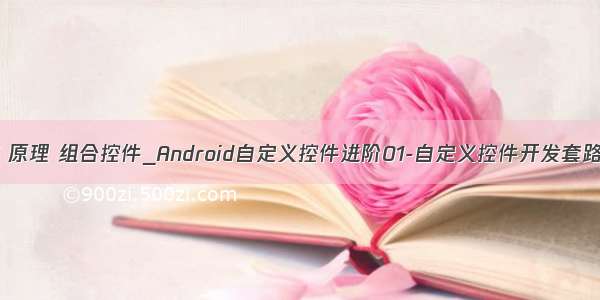
目标:实现textview和ImageButton组合,可以通过Xml设置自定义控件的属性。
1.控件布局:以Linearlayout为根布局,一个TextView,一个ImageButton。
Xml代码 1<?xmlversion="1.0"encoding="utf-8"?>
2<LinearLayoutxmlns:Android="/apk/res/android"
3android:layout_width="fill_parent"android:layout_height="fill_parent"
4android:gravity="center_vertical">
5<TextViewandroid:layout_height="wrap_content"android:id="@+id/text1"
6android:layout_width="wrap_content"></TextView>
7<ImageButtonandroid:layout_width="wrap_content"
8android:layout_height="wrap_content"android:id="@+id/btn1"></ImageButton>
9</LinearLayout>
2.自定义控件代码,从LinearLayout继承:
Java代码 publicclassImageBtnWithTextextendsLinearLayout{
}
publicImageBtnWithText(Contextcontext){
this(context,null);
}
publicImageBtnWithText(Contextcontext,AttributeSetattrs){
super(context,attrs);
LayoutInflater.from(context).inflate(R.layout.imagebtn_with_text,this,true);
}
}
在构造函数中将Xml中定义的布局解析出来。
3.在主界面布局xml中使用自定义控件:
Xml代码 <com.demo.widget2.ImageBtnWithText
android:id="@+id/widget"
android:layout_width="fill_parent"
android:layout_height="fill_parent"/>
即使用完整的自定义控件类路径:com.demo.widget2.ImageBtnWithText定义一个元素。
运行可以看到控件已经能够被加载到界面上。
4.给按钮设置图片和文本
如果图片是固定不变的,那么直接在控件布局中设置ImageButton的src属性即可。
4.1通过Java代码设置,在控件代码中提供函数接口:
Java代码 publicvoidsetButtonImageResource(intresId){
mBtn.setImageResource(resId);
}
publicvoidsetTextViewText(Stringtext){
mTv.setText(text);
}
然后再在主界面的onCreate()通过函数调用设置即可。
4.2通过Xml设置属性
4.2.1首先定义Xml可以设置的属性集合,在values下创建attrs.xml,文件名可随意,一般都叫attrs.xml
Xml代码 <?xmlversion="1.0"encoding="utf-8"?>
<resources>
<declare-styleablename="ImageBtnWithText">
<attrname="android:text"/>
<attrname="android:src"/>
</declare-styleable>
</resources>
属性集合名字:ImageBtnWithText,自己可根据实际来定义;
集合中包含的属性列表,每行一个属性。
4.2.2修改自定义控件实现代码,以获取xml中定义的属性
Java代码 TypedArraya=context.obtainStyledAttributes(attrs,R.styleable.ImageBtnWithText);
CharSequencetext=a.getText(R.styleable.ImageBtnWithText_android_text);
if(text!=null)mTv.setText(text);
Drawabledrawable=a.getDrawable(R.styleable.ImageBtnWithText_android_src);
if(drawable!=null)mBtn.setImageDrawable(drawable);
a.recycle();
首先通过context.obtainStyledAttributes获得所有属性数组;
然后通过TypedArray类的getXXXX()系列接口获得相应的值。
4.2.3在主界面布局中设置自定义控件的属
android:text="ABC" android:src="@drawable/icon
4.3自定义名称属性:
在4.2中使用的属性名是Android系统命名空间的,都以android开头,比如android:text等。
实际开发中会自定义一些属性名,这些属性名仍然定义在4.2.1提到的attrs.xml中:
4.3.1定义属性名
Xml代码 <attrname="appendText"format="string"/>
和直接使用系统的attr不同的是要增加一个format属性,说明此属性是什么格式的。format可选项可参见注1
4.3.2使用自定义属性
Xml代码 <?xmlversion="1.0"encoding="utf-8"?>
<LinearLayoutxmlns:android="/apk/res/android"
xmlns:myspace="/apk/res/com.demo.customwidget"
android:orientation="vertical"android:layout_width="fill_parent"
android:layout_height="fill_parent">
<com.demo.widget2.ImageBtnWithText
android:text="ABC"android:src="@drawable/icon"android:id="@+id/widget"
android:layout_width="fill_parent"android:layout_gravity="center"
android:layout_height="fill_parent"myspace:appendText="123456">
</com.demo.widget2.ImageBtnWithText>
</LinearLayout>
直接在主布局文件中使用此属性appendText="abc"是不会设置生效的,而是要在主布局xml中定义一个xml命名空间:
xmlns:myspace="/apk/res/com.demo.customwidget"
命名空间的名字可以自己随便定义,此处为myspace,即xmlns:myspace;
后面的地址则有限制,其开始必须为:"/apk/res/",后面则是包名com.demo.customwidget,
此处的包名与AndroidManifest.xml中< manifest>节点的属性package="com.demo.customwidget"一致,不是自定义控件Java代码所在的包,当然简单的程序自定义控件Java代码也一般在此包内。
注1:format可选项
"reference" //引用
"color" //颜色
"boolean" //布尔值
"dimension" //尺寸值
"float" //浮点值
"integer" //整型值
"string" //字符串
"fraction" //百分数,比如200%
枚举值,格式如下:
< attr name="orientation">
< enum name="horizontal" value="0" />
< enum name="vertical" value="1" />
< /attr>
xml中使用时:
android:orientation = "vertical"
标志位,位或运算,格式如下:
< attr name="windowSoftInputMode">
< flag name = "stateUnspecified" value = "0" />
< flag name = "stateUnchanged" value = "1" />
< flag name = "stateHidden" value = "2" />
< flag name = "stateAlwaysHidden" value = "3" />
< flag name = "stateVisible" value = "4" />
< flag name = "stateAlwaysVisible" value = "5" />
< flag name = "adjustUnspecified" value = "0x00" />
< flag name = "adjustResize" value = "0x10" />
< flag name = "adjustPan" value = "0x20" />
< flag name = "adjustNothing" value = "0x30" />
< /attr>
xml中使用时:
android:windowSoftInputMode = "stateUnspecified | stateUnchanged|stateHidden">
另外属性定义时可以指定多种类型值,比如:
< attr name = "background" format = "reference|color" />
xml中使用时:
android:background = "@drawable/图片ID|#00FF00"
最后来个完整实例:
Java代码 importandroid.content.Context;
importandroid.content.res.TypedArray;
importandroid.util.AttributeSet;
importandroid.view.LayoutInflater;
importandroid.view.View;
importandroid.widget.ImageButton;
importandroid.widget.LinearLayout;
importandroid.widget.ProgressBar;
publicclassMeterextendsLinearLayout{
privateintmax=100;
privateintincrAmount=1;
privateintdecrAmount=-1;
privateProgressBarbar=null;
publicMeter(finalContextctxt,AttributeSetattrs){
super(ctxt,attrs);
this.setOrientation(HORIZONTAL);
TypedArraya=ctxt.obtainStyledAttributes(attrs,R.styleable.Meter);
//获取里面属性用"名字_属性"连接起来
max=a.getInt(R.styleable.Meter_max,100);
incrAmount=a.getInt(R.styleable.Meter_incr,1);
decrAmount=-1*a.getInt(R.styleable.Meter_decr,1);
a.recycle();
}
//当View中所有的子控件均被映射成xml后触发
@Override
protectedvoidonFinishInflate(){
super.onFinishInflate();
//((Activity)getContext()).getLayoutInflater().inflate(R.layout.meter,this);
LayoutInflater.from(getContext()).inflate(R.layout.meter,this);
bar=(ProgressBar)findViewById(R.id.bar);
bar.setMax(max);
ImageButtonbtn=(ImageButton)findViewById(R.id.incr);
btn.setOnClickListener(newView.OnClickListener(){
publicvoidonClick(Viewv){
bar.incrementProgressBy(incrAmount);
}
});
btn=(ImageButton)findViewById(R.id.decr);
btn.setOnClickListener(newView.OnClickListener(){
publicvoidonClick(Viewv){
bar.incrementProgressBy(decrAmount);
}
});
//this.addView(view);//不需要add,默认已经add了
}
}
attrs.xml:
Xml代码 <?xmlversion="1.0"encoding="utf-8"?>
<resources>
<declare-styleablename="Meter">
<attrname="max"format="integer"/>
<attrname="incr"format="integer"/>
<attrname="decr"format="integer"/>
</declare-styleable>
</resources>
meter.xml文件:
Xml代码 <?xmlversion="1.0"encoding="utf-8"?>
<LinearLayoutxmlns:android="/apk/res/android"
android:orientation="horizontal"
android:layout_width="fill_parent"
android:layout_height="wrap_content"
>
<ImageButtonandroid:id="@+id/decr"
android:layout_height="wrap_content"
android:layout_width="wrap_content"
android:scaleType="fitCenter"
android:src="@drawable/arrow_down"
/>
<ProgressBarandroid:id="@+id/bar"
style="?android:attr/progressBarStyleHorizontal"
android:layout_width="wrap_content"
android:layout_height="wrap_content"
android:layout_weight="1"
android:layout_gravity="center_vertical"
/>
<ImageButtonandroid:id="@+id/incr"
android:layout_height="wrap_content"
android:layout_width="wrap_content"
android:scaleType="fitCenter"
android:src="@drawable/arrow_up"
/>
</LinearLayout>
使用:
Java代码 @Override
publicvoidonCreate(BundlesavedInstanceState){
super.onCreate(savedInstanceState);
setContentView(R.layout.main);
}
main.xml:
Xml代码 <?xmlversion="1.0"encoding="utf-8"?>
<LinearLayoutxmlns:android="/apk/res/android"
xmlns:app="/apk/res/com.ql.app"
android:orientation="horizontal"
android:layout_width="fill_parent"
android:layout_height="wrap_content"
>
<com.ql.app.Meter
android:id="@+id/meter"
android:layout_width="fill_parent"
android:layout_height="wrap_content"
app:max="100"
app:incr="5"
app:decr="5"
/>
</LinearLayout>
Trackback:/blog/1040917
















